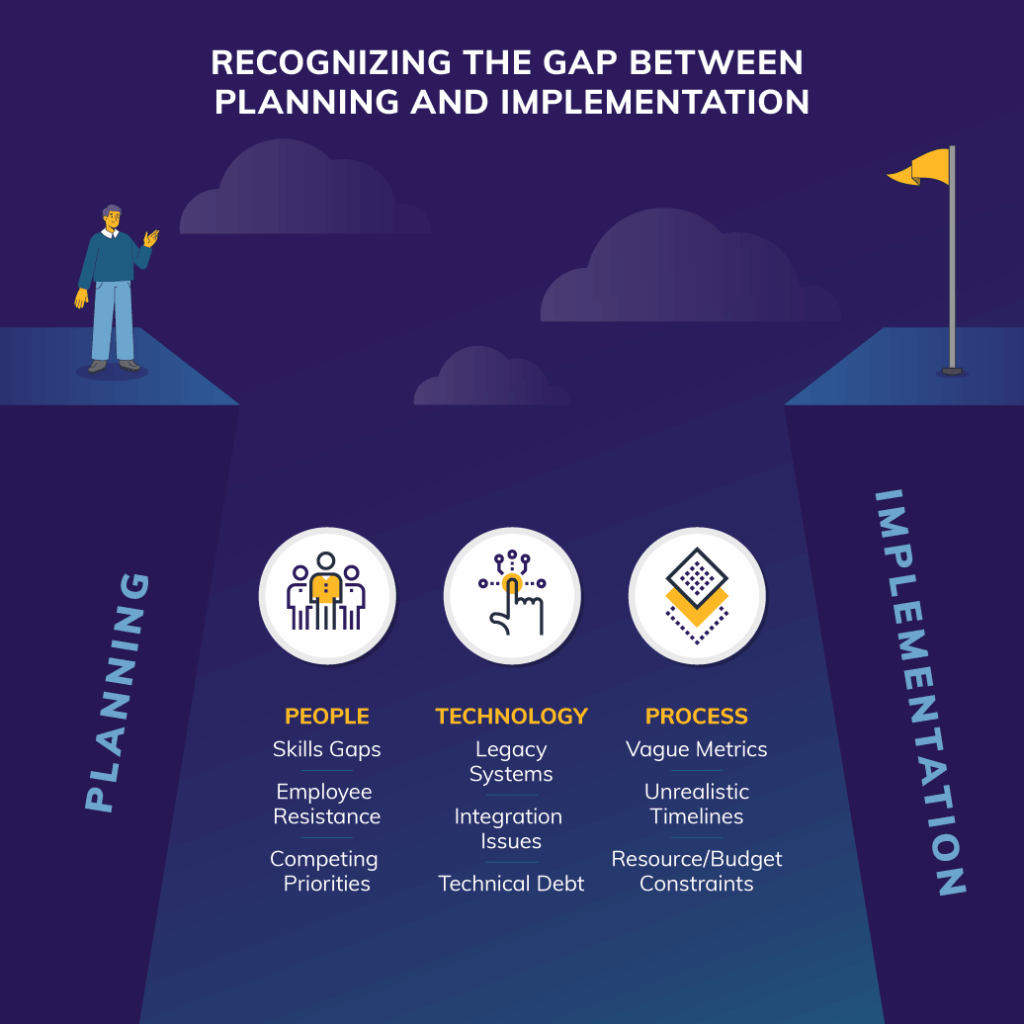We address the execution gap plaguing IT strategy implementations. We identify the most common roadblocks, from resource constraints and stakeholder misalignment to change resistance and technology integration issues, and we provide proven frameworks for overcoming them.
In brief:
- Many IT strategy implementations fail during execution, not planning.
- Common roadblocks include resource constraints, stakeholder misalignment, resistance to change, and issues with technology integration.
- Successful implementation requires overcoming legacy system limitations, managing competing priorities, and addressing complex system interdependencies.
- Effective change management is key to bridging the gap between strategy and execution.
According to Harvard Business Review, nearly 60 to 90 percent of strategies never take off, and that failure often starts in the middle. Planning goes well, the project kicks off, and then somewhere along the line, the company never executes the strategy.
These facts highlight a significant gap between planning and implementation. In this article, we share our best practical advice for overcoming challenges in IT strategy implementation.
Together, our subject matter experts have decades of experience leading projects across various industries, driving effective change management and project success. We’ll discuss why IT strategies fail, eight critical implementation roadblocks, how to phase implementation, and how to leverage change management successfully.
Why IT Strategies Fail — The Execution Gap
Great strategy often isn’t enough. Enterprise environments are complex, and when you’re dealing with people, many will resist change. Hilary Lee, National People and Change Practice Lead, says, “People believe the technology will solve the problem. But when there’s poor execution, a good strategy just can’t execute itself.”
Potential challenges with execution include:
- Legacy constraints with old systems or technical debt
- Competing priorities and lack of resources
- Deeply interconnected complex systems
- Security and compliance considerations
Closing the execution gap often means pairing a great IT strategy with strong change management, stakeholder alignment, and strong project management. Let’s discuss the potential implementation roadblocks you might encounter.
The Eight Critical IT Strategy Implementation Roadblocks
IT strategy implementations fail for various reasons, often due to common execution roadblocks. These tipping points can completely derail enterprise-level business transformation. Strong IT planning involves preparing in advance for these challenges, rather than reacting to them after they arise.
In my personal experience, I’ve seen balancing speed and buy-in and skills gaps as the biggest challenges that completely derail an implementation. Here are a few things to look out for:
- Resource constraints and budget allocation challenges: An IT project might be a top-priority one year, and the next year, something unexpected, such as a merger, comes along. This detracts resources, budget, and attention away from the IT strategy.
- Stakeholder misalignment and competing priorities: When different departments have conflicting goals, it becomes easy to stall progress on IT implementations.
- Employee resistance to change: Employees might resist adopting new methods or find workarounds to revert to old ways, especially if an implementation comes with system outages or a poor user experience.
- Unrealistic timelines: Timeline constraints cause pressure that creates security gaps, downtime, and undermines stability.
- Technology integration and legacy system complexities: It’s not easy to integrate enterprise-level CRMs, ERPs and cloud platforms to work together seamlessly, especially if some of the technologies are in an older, traditional environment.
- Risk management blind spots: Unexpected security issues can quickly derail an entire project.
- Vague strategic goals and success metrics: Conflicting goals, vague metrics, or undefined end states create confusion and chaos, especially when implementation gets tricky.
- Skills gaps and capability limitations: As technology accelerates, skills gaps become increasingly critical issues, while education lags behind.
These roadblocks are critical moments of potential derailment, but building a strong implementation foundation can alleviate some of the pressures.
Build Your Implementation Foundation
David Lefever, Vice President of Cybersecurity at Centric, says, “You’ve heard it before, but start with the end state in mind.” Follow the checklist below to establish a solid implementation foundation that aligns teams from the outset and fosters realistic expectations.
- Start with clear, measurable strategic objectives.
- Establish cross-functional governance.
- Stick with a specific cadence of comprehensive but targeted stakeholder communication.
- Plan and allocate resources appropriately.
Once you have a strong foundation, it’s essential to take a phased approach to strategic implementation as well.
The Phased IT Strategy Implementation Methodology
A phased strategic implementation breaks down complex approaches into manageable phases, establishes milestones, tracks progress, and balances quick wins with long-term objectives.
Practical ways to implement a phased rollout include:
- Starting with a small pilot program around a high-value department, but with low impact
- Creating time-bound checkpoints with measurable goals, such as data accuracy, the number of employees trained, and so on.
- Launching early victories to establish confidence and build momentum
- Layering in one integration at a time, and troubleshooting regularly
- Building user feedback into key phases
For example, at Centric, we developed a strategy to improve the IT service desk of a specialty construction and infrastructure company serving the utility industry. The company lacked the data to determine service desk performance and was unsure about its current service desk software.
First, we broke our strategy development into four manageable steps:
- Initiate and Scope: In this “Where Are We?” stage, we established the project team, began gathering management objectives and perspectives, and mapped business objectives to service desk objectives.
- Assess Current State: To determine “Where Are We Going?” we developed the service desk’s mission, prioritized projects based on business needs and limitations, and identified key measures.
- Design Future State: Our future state design included 10 key areas, including ticket management, critical incident management, and knowledge management.
- Build Roadmap and Execution Plan: We answered the question “How Will We Get There?” by developing service desk scenarios, creating a roadmap to the future state, collaborating with leadership to secure commitments and allocate resources, and preparing for execution.
This type of phased transformation breaks down a large IT strategy implementation into manageable, realistic chunks. It helps lower risk, speed up adoption, and build organizational trust.
We also included risk mitigation and contingency planning, because it’s never a question of “if” something will go wrong, but “when.”
Risk Mitigation and Contingency Planning
Even the most carefully constructed plans come with bumps. Proactive risk mitigation isn’t about preventing every single problem but planning for likely issues.
- Proactive risk identification and assessment frameworks: Establish a process for surfacing issues early. Categorize risks by impact.
- Implementation plans with flexibility built in: Carefully design buffer time, and create escalation protocols for when issues exceed acceptable thresholds.
- Early warning systems and course correction protocols: Monitor adoption and performance in real-time, and empower project leaders to speak up.
- Real-world scenario planning: Create step-by-step playbooks, explore tabletop exercises, and document recovery steps.
Once you have a strong foundation, a phased rollout approach, and have considered risks, it’s time to select your technology and compare vendors.
How to Select Technology and Evaluate Vendors
Don’t just buy software. Look for a strategic, long-term partner with deep industry expertise. Evaluate vendors that have successfully launched similar projects, because they’ll have a wealth of knowledge to contribute.
At Centric, we’re fortunate to have a robust talent bench in data analytics, cybersecurity, and risk management. That makes it easy to bring in experts for a project without requiring our client to source a new vendor for support.
Here are a few best practice tips for selecting a technology vendor:
- Map out features and capabilities to specific business goals.
- Look for vendors with particular implementation support.
- Prioritize vendors with open APIs, integrations and flexible but secure architecture.
- Make sure vendors drive their own innovation and change, but not at the risk of security.
How to Use Change Management in IT Transformation
Change management is the heart of everything in IT transformation. Establishing an embedded change management approach from the beginning allows teams to clearly measure adoption, establish training, and monitor usage even after implementation.
The ideal change management team is a small group of experts that brings the methodology, approach and tools, but also the practitioners’ know-how.
- Bring in internal champions and change agents early on.
- Keep status memos targeted and focused.
- Provide executives with high-level details.
- Establish proactive training to manage resistance and accelerate adoption.
This is the approach we took with our specialty construction and manufacturing client, because they align with our change management principles. We worked collaboratively with executives, managers and employees to define our strategy.
This helped our project integrate across the enterprise to provide a cohesive experience for everyone. We then tailored our training and communications for various audiences.
Throughout the process, agility remained a key focus, both to overcome challenges and to set the organization up for continuous improvement.
Finally, we used a data-driven approach. Data not only informed our change management work but also helped establish the right metrics for project success for the service desk project.
The Most Critical Steps for Measuring Performance
As Lee says, “You can’t change what you don’t measure.” Define the most critical KPIs upfront, and select only 3 to 5 to focus on. Establish regular assessment and adjustment protocols to create structured views and dashboards for senior executives for alignment. Celebrate milestones to maintain momentum across long implementation timelines and publicly highlight essential contributions.
When it comes to post-implementation optimization, rely on user feedback and closely monitor any changes in sentiment. For example, two months after using a new platform, employees might uncover potential security issues or connectivity errors.
Build Long-Term Strategy Execution Capabilities
Business transformation isn’t a one-off project. It’s about the ability to execute at a high level again and again. Start by developing internal project management expertise and creating reusable frameworks and processes to drive consistency and standardization. This helps accelerate future rollouts and prevents rework.
After implementations, schedule post-mortem breakdowns to assess what worked well and what didn’t. Aggregate learnings for future improvements, and include all users and stakeholders in the feedback process.
Also, prepare for a long-term transition by using a third-party expert. This provides a fresh perspective, along with a team of specialized experts with deep industry expertise. Working with an expert vendor like Centric balances the team’s workload, prevents burnout, and allows them to focus on day-to-day strategic objectives. For example, if you’re exploring artificial intelligence (AI) implementation, an expert partner can support strategy, governance, security and development.
Turn IT Strategy Implementations into Long-Term Success
Developing a long-term strategic IT plan requires creating a comprehensive roadmap that encompasses everything from infrastructure upgrades to emerging technologies, such as AI and cloud computing. The most valuable advice I have, based on hundreds of IT strategy implementations across dozens of industries, is to identify the right stakeholders and meet regularly.
We understand the pivotal role of IT in driving business value. We can work closely with leadership and IT teams to align technology with business strategy and help you discover the ROI that cutting-edge technologies can offer. Let’s Talk






